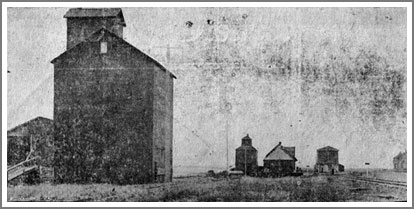
An Early View of Belmont , “by the tracks”
Mrs. Vincent with other members of her family climbed the highest peak
on their land to watch the first train go through.
They watched with weary eyes the far horizon until a faint grey streak
appeared many miles away. The children danced with delight; but
strange emotions brought tears to the eyes of the elders, as the first
train rumbled its way across the lonely prairie.
Belmont is 130 miles from Winnipeg. Its population is between 300 and
400.
Up until the year 1879, the municipality of Argyle (as it was then
known) was a wilderness of bluffs and prairie grasses in which the wolf
badger and prairie hen found shelter
Settlers came in with ox teams and wagon. It was with these, prior to
1891 that they travelled to Brandon for supplies. There were no houses
along the road, so they slept beneath their wagons. It was a sixty mile
trail, along the high ridge of hills circling from the Donaghy place,
around J. B. Matchett's hill, along the ridge to McDonald's.
In the spring of 1881, a number of land hunters struck the west half of
the municipality all the land between Old Millford and what was later
the homestead of J. D. Gordon being open for settlement. The land
presen¬ted itself to the settlers, rolling or level prairie to choose
from. Many of these pioneers built their homesteads and then had to
walk to Deloraine to purchase the land.
In 1882 quite a number of immigrants settled in this part of the
municipality. Some of these were: Chas. Martin, John Nicholson, C.
Drumond Hay, George Maw, Smith Bro¬thers, Yellowleas, C. Andrews; also
J. Scott and sons near Hilton. Mrs. Sam Fargey was the first woman
settler and Roy Schultz, second son of Mr. and Mrs. Frank Schultz, was
the first child born in the district.
As a farming district, Belmont was unsurpassed. The wheat grown by Mr.
Thomas Gibson of Oak Grove farm took the first prize at an exhibition
in Winnipeg, beating compet¬itors from every part of Canada and the
United States which lays claim to growing good wheat.
In 1883, Mr. John O. Bell homesteaded the beautiful homestead where
Belmont now stands. His house is the home of Mrs. J. T. Smith now. When
the town sprang up, it was named after its pioneer citizen and thus
became known as Belmont.
In 1890 the coming of the Northern Pacific Railway started a number of
towns on the Morris-Brandon branch and among them
|
|
was Belmont, situated on Sec. 20-5-15;
102 miles from Morris, 52 miles from Brandon. Belmont was the junction
of the Belmont-Virden extension of the C.N.R. which the people hoped
would some day be the main line from Winnipeg, The first railroad ran
through Belmont in 1889, making Belmont a divisional point. In 1889
the yards had been extended to contain a coal dock pumping station,
washout plant, and round house. The company then employed 23 men, with
a monthly payroll of $1500.
The running of this line right through the centre of the municipality
was hailed with delight by the farmers. They broke up more land and
many bought new land. On account of the improved market facilities, an
era of prosperity was ushered in. Prior to this time, farmers had
hauled wheat in wagons to Killarney, and sold it for twenty-two cents a
bushel.
Sometime after the coming of the railway to Belmont, an amusing
incident is still remembered, and told by those who went on the free
trip to Winnipeg, given to the settlers along the line from Belmont to
Virden. There were many waiting at Ninette and Lowland Scotchman
finally succeeded in settling himself in the only vacant chair.
Expecting the station to be part of the train, he remarked, "She can
gang awa' any time noo, I'm ready."
In some localities the old trails are still used, though they give
rather rough service. Roads were constructed and bridges built, and
soon the municipality had a more civilized appearance.
The first store was owned by the Axford brothers in 1889. It is now
owned by Harrison and Sons,. The first post office was built in 1891,
and received the name of Craiglea. By 1899 there had appeared the
fol¬lowing business places: J. H. Standing, merchant; G. Tumoth; Chas.
Cannon, banker; F. Sparks, hardware; A. Houghton, implement agent J.
T. Smith, merchant; Joseph Kerr; implement agent; J. R. Spears, baker
W. S. Fargey, lumber yard; J. Bulgar, butcher; T. McLennan, blacksmith
J. T. Mutchmore, M. D.; A. Marquis, tailor; Robt. Scott, editor of the
Bel¬mont Star.
In 1899 there were twenty schools in the municipality. Before the town
was begun the home of J. D. Gordon served as a school, and Miss K.
McPhail was the first teacher. About 1890 this school was drawn into
town. It is now the residence of the janitor, Mr. Owen. The home of
Mrs. Ternter was then used as a school. In 1903 the new school was
built.
When the town was in its infancy there was neither church nor
prea¬cher. However travelling preachers visited Belmont regularly,
stopping usually at the home of J. C. Smith. Services were carried on
at his home until the first church was built. This is today the home of
Mr. Jno. Briscoe.
Thus Belmont has grown from fields of waving grain to the
prosperous little town where we live. The credit does not
belong to us, but to our pioneers. Although the lack of transportation
was at first a serious drawback, entailing a great deal of
hardship, their faith in the country remained
unshaken. These settlers were indeed home makers.
|

